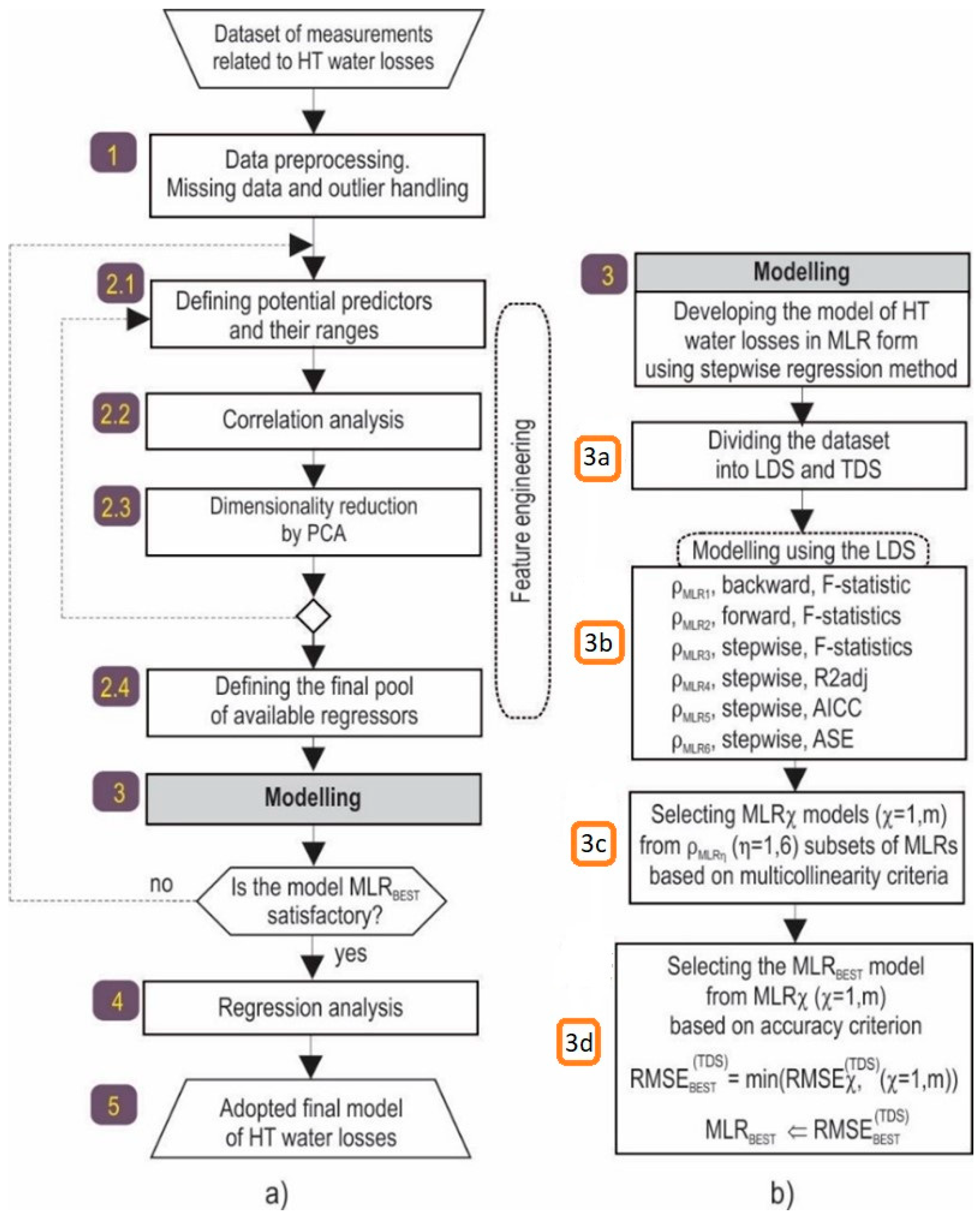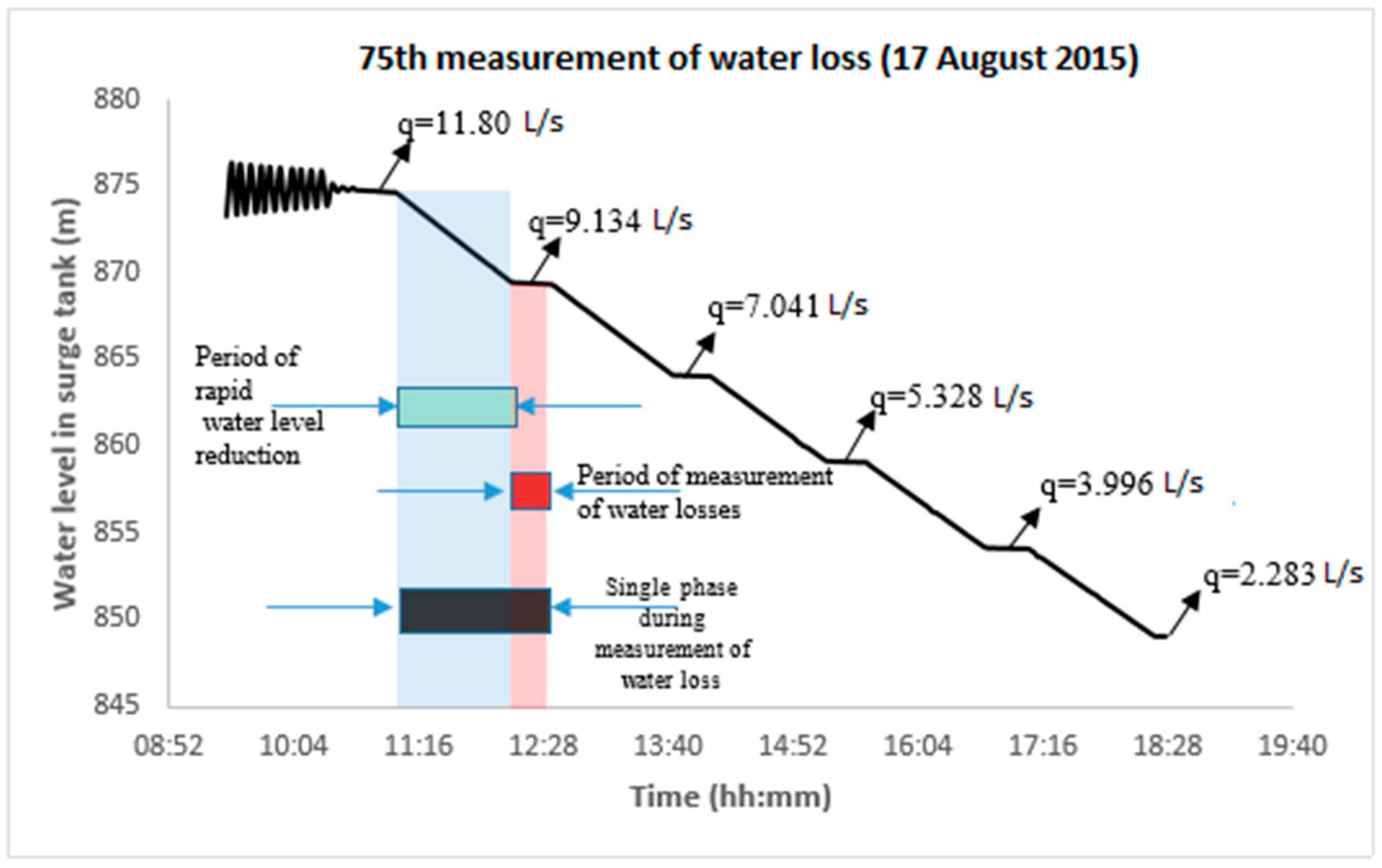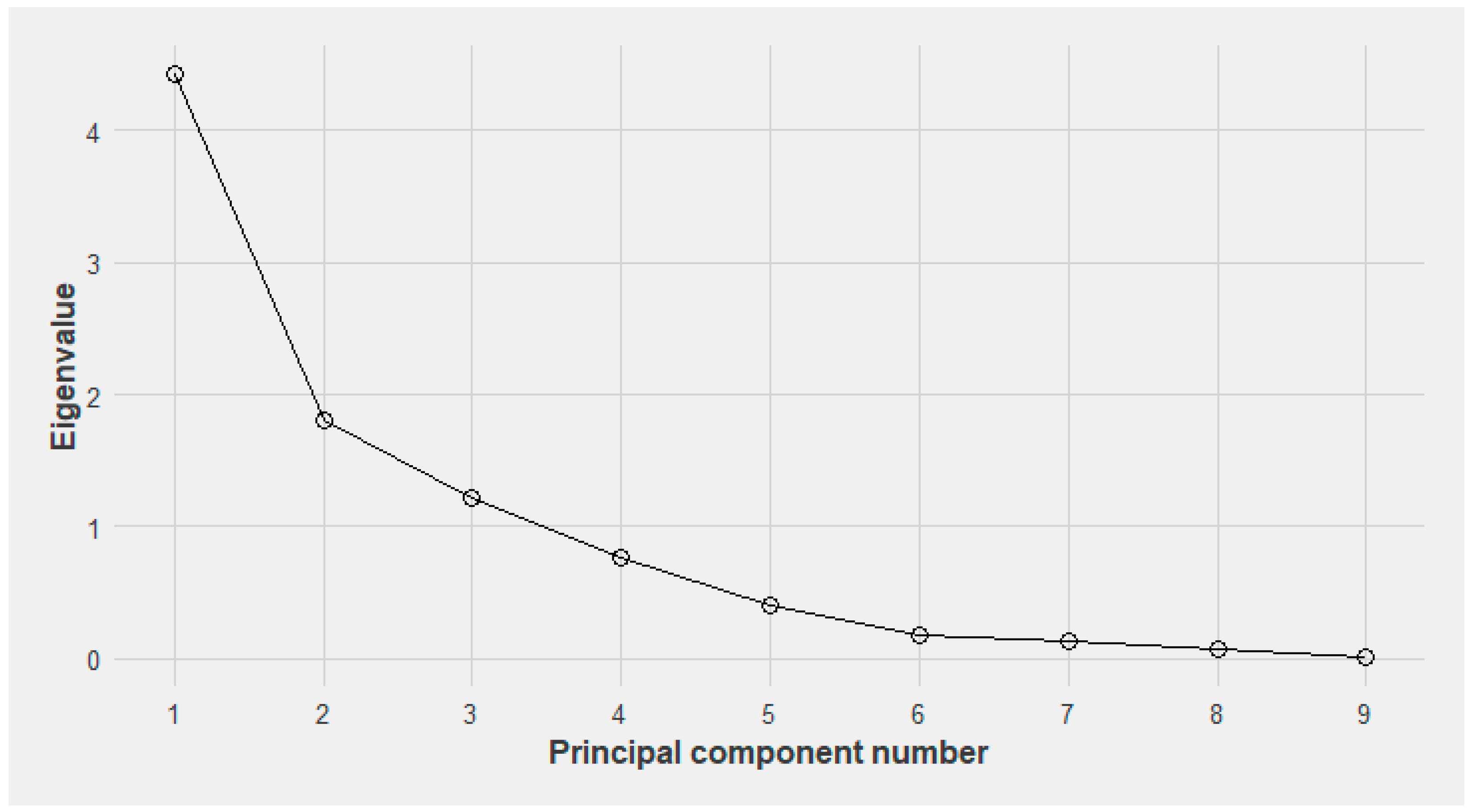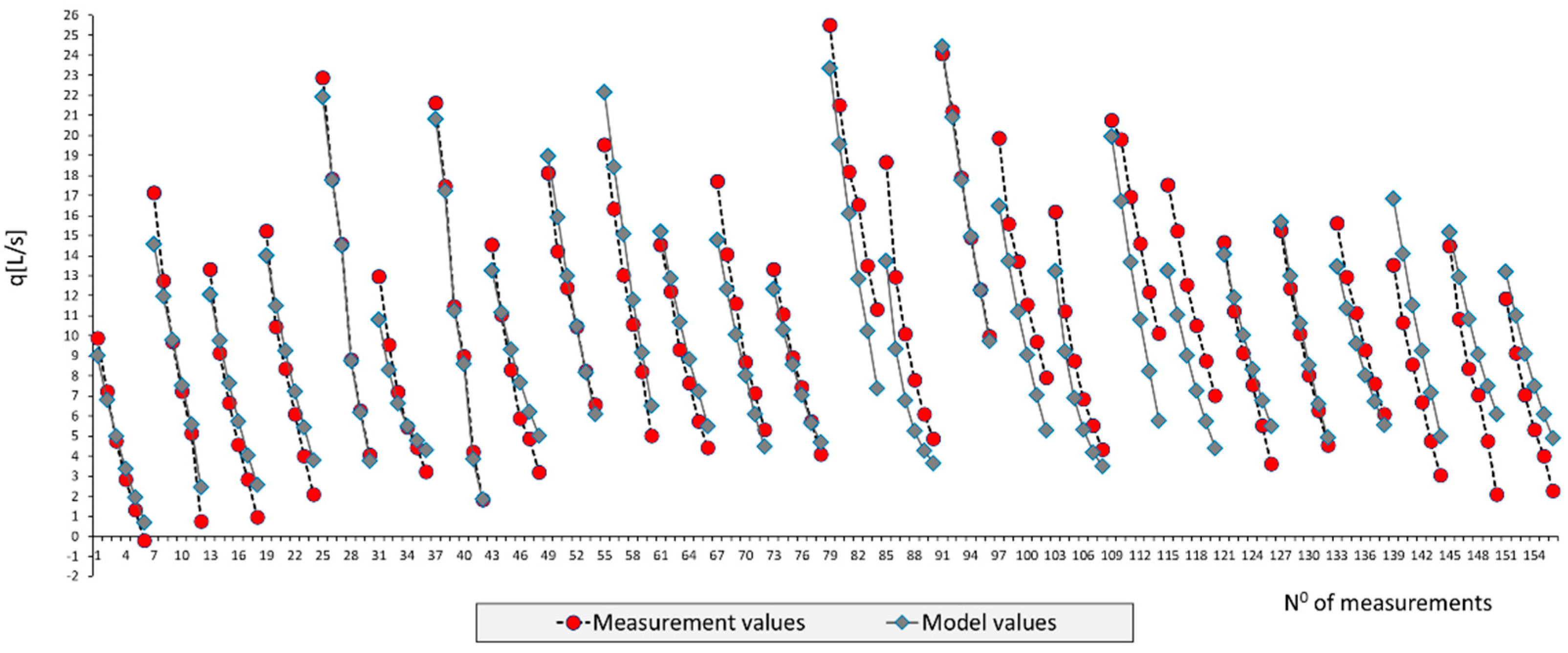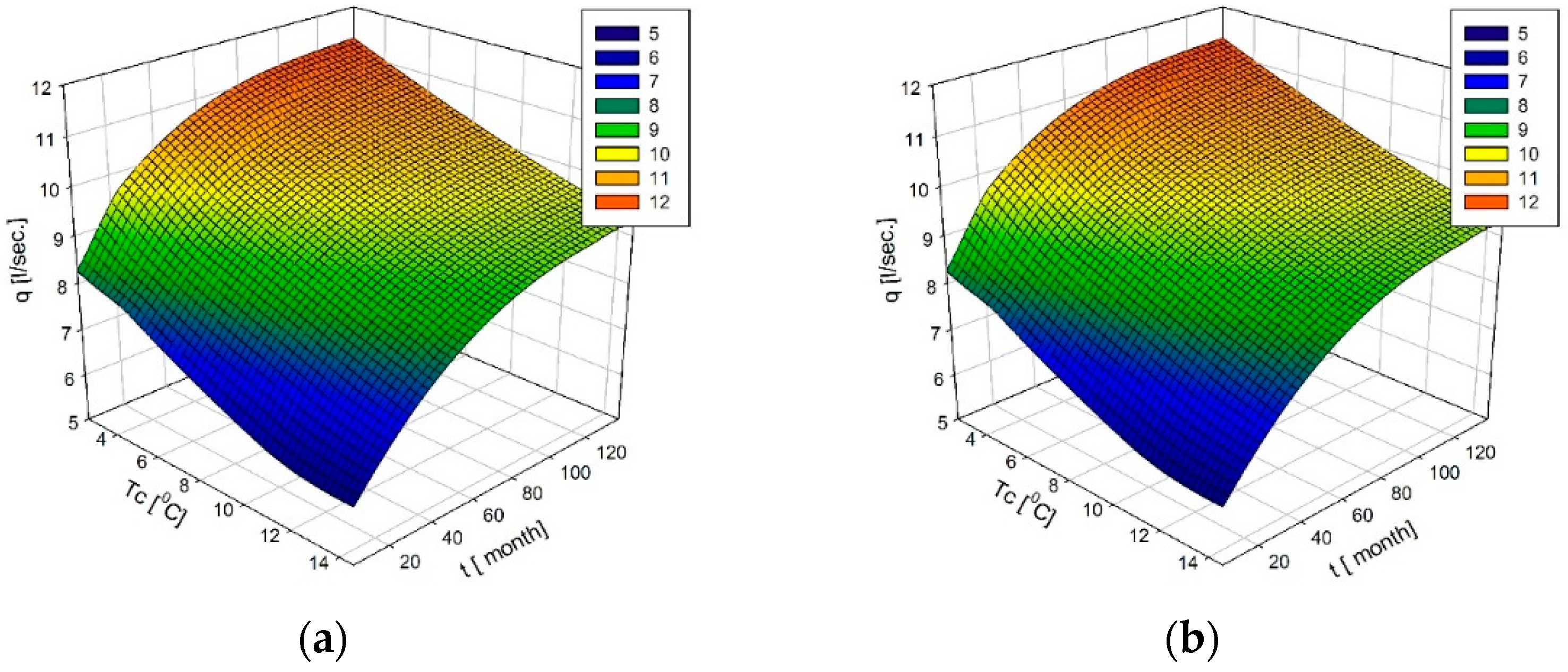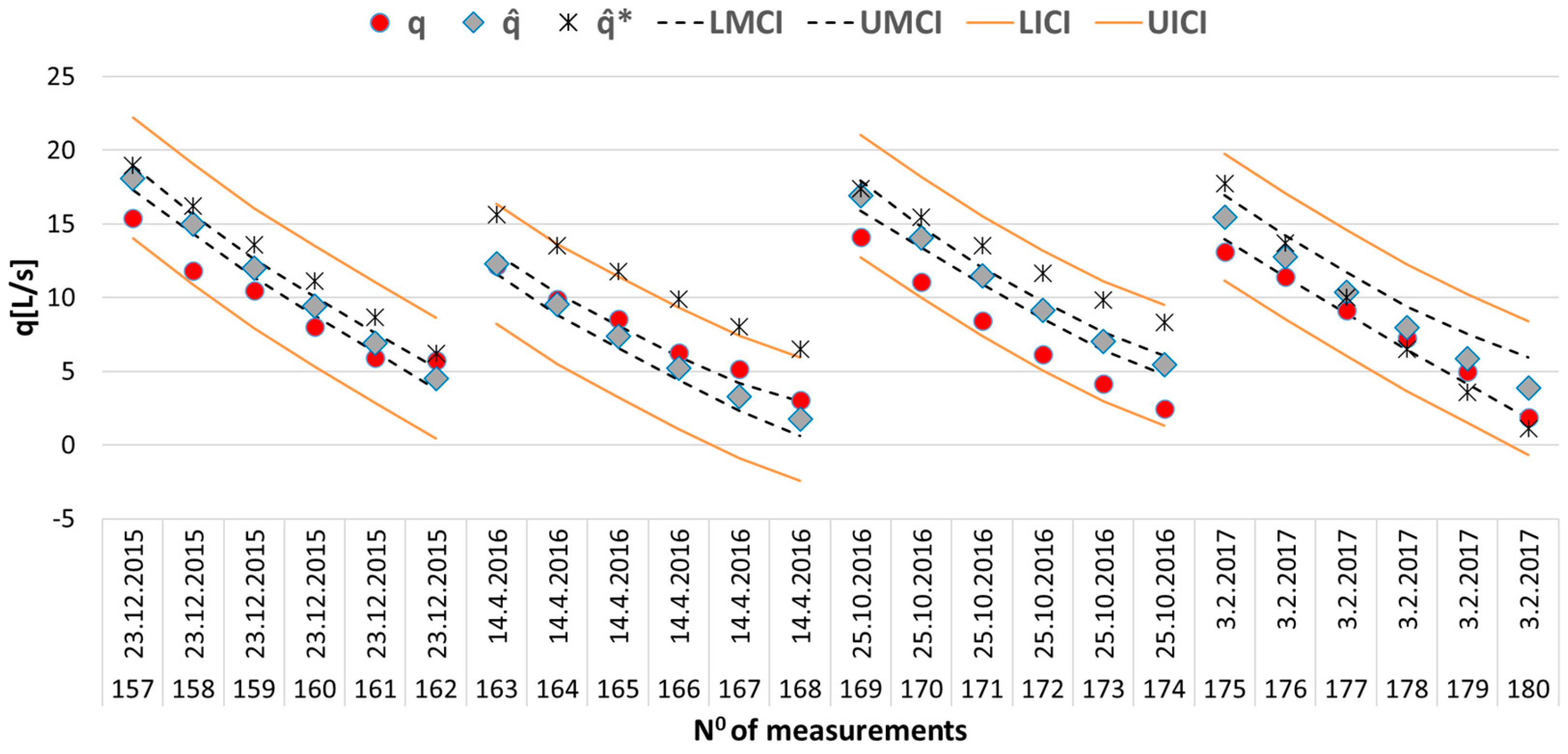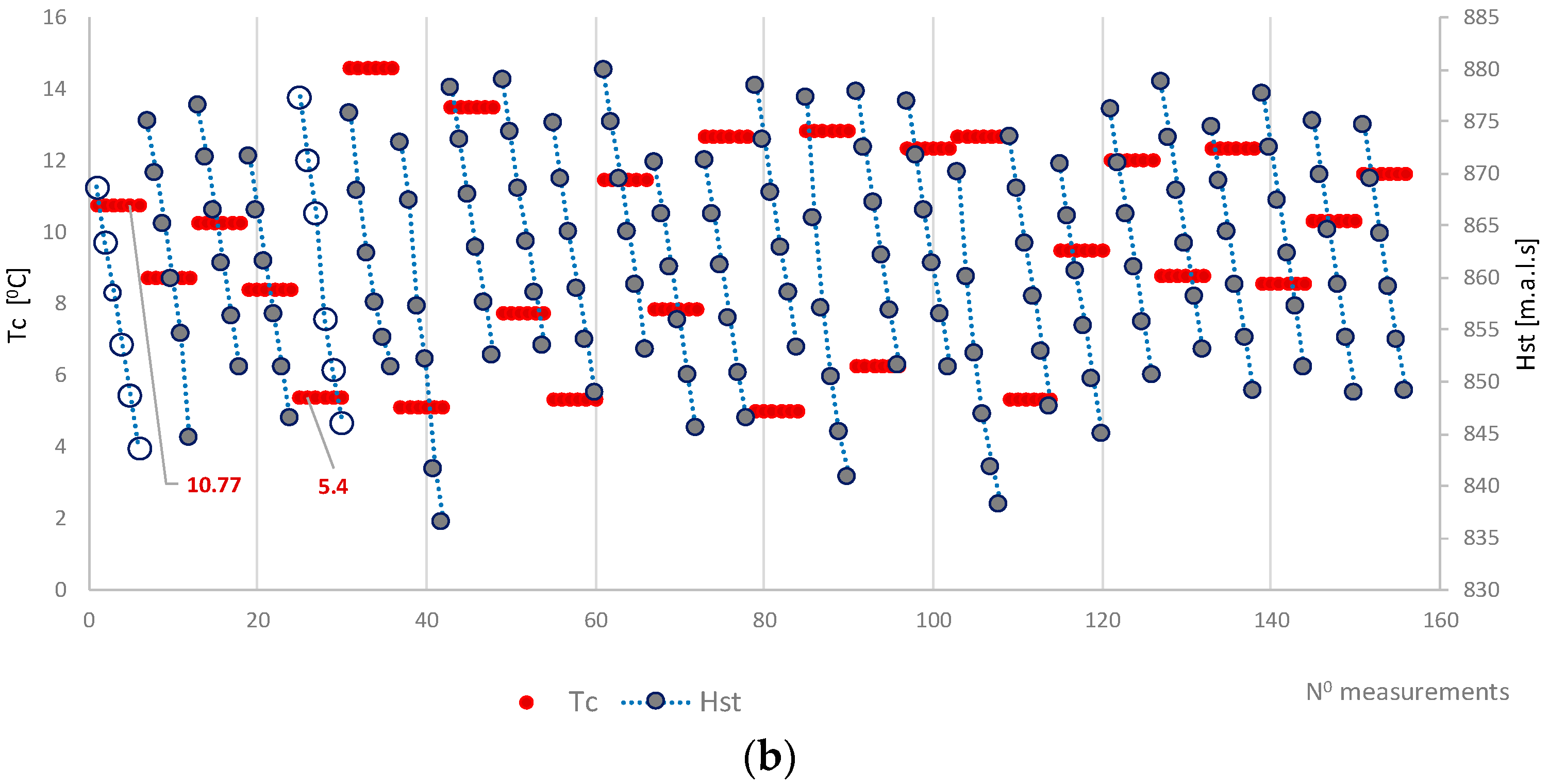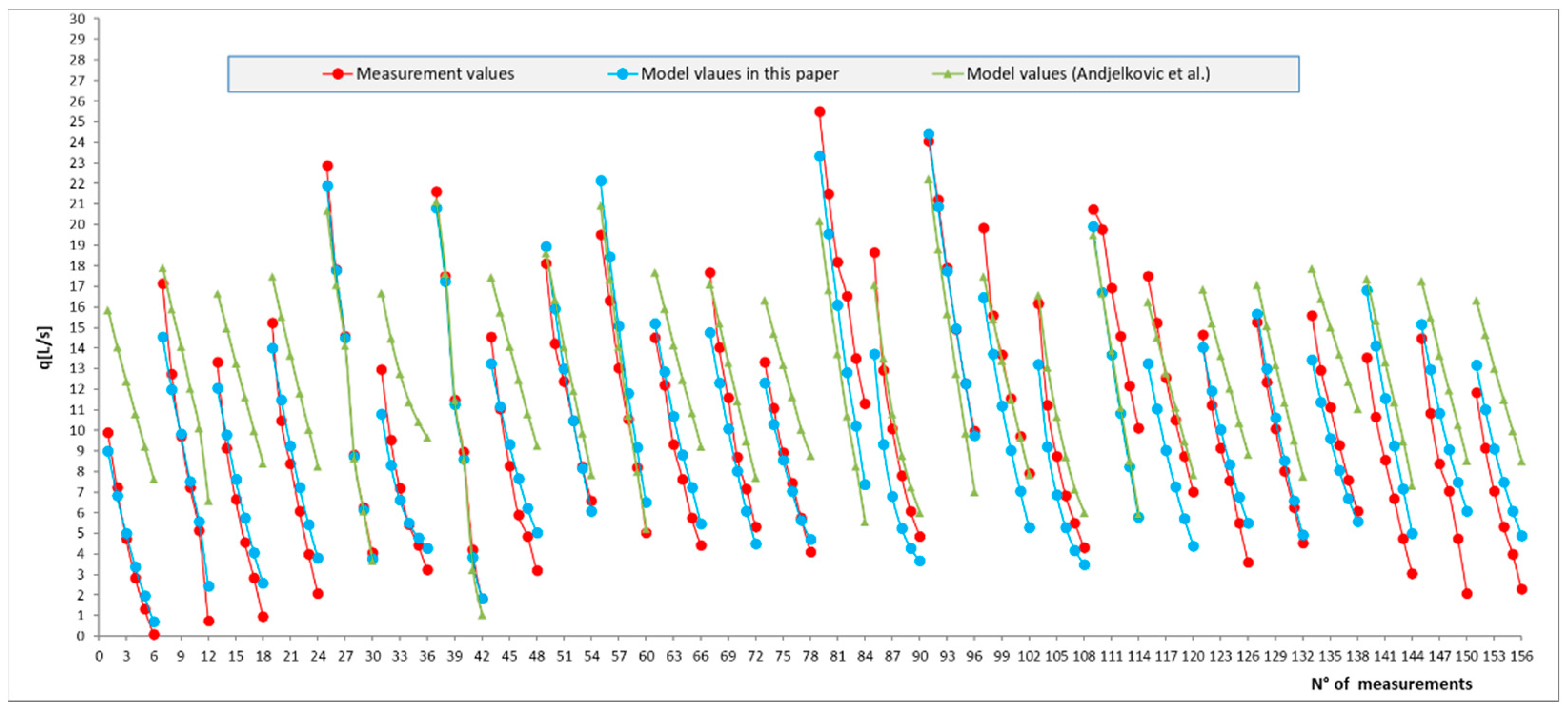1. Introduction
Hydraulic tunnels subject to the high internal pressure of water (HT) are mostly used to carry water from the reservoir to the hydropower plant machine building with turbines. The hydraulic fall that exists between the reservoir and the power plant produces the internal water pressure in the hydraulic tunnel. Internal water pressure can cause tensile stresses and cracks in concrete tunnel lining and thus generate static instability in terms of failure and functional instability in terms of water losses from the tunnel. The water loss in the tunnel occurs through various cracks and fissures in the concrete lining. Some cracks are clearly visible, while some smaller cracks are not. On the other hand, the rock mass affects the increase or decrease of total water loss, depending on the porosity and degree of jointing of the rock mass. It is because of this that hydrotechnical tunnels are grouted, so as to fill the cracks around the tunnel and therefore lower the permeability of the rock mass. The water lost from inside the tunnel ends up in the surrounding rock mass, which can have an additional negative impact on the mechanical and deformation properties of the rock mass [
1,
2,
3]. Besides the grouting measures for filling the rock mass cracks, the elimination of tensile stresses in the concrete lining, and therefore securing functionality and stability of hydraulic tunnels under pressure, is most effectively achieved by stress injection [
4]. Other approaches exist as well, such as the use of reinforced concrete tunnel linings in order to prevent the formation of cracks [
5].
In HT, appropriate monitoring is carried out during the structure’s lifetime. Based on the monitoring, appropriate stability and functionality estimates (SaFE) for the tunnel can be made. The assessment of stability and functionality for the HT is performed based on measurements of significant physical quantities and a variety of physical, mathematical, and other models that describe the processes related to HT. The most frequent measurements are water losses in the tunnel, temperature of concrete, the temperature of water and rock, opening and closing of cracks, groundwater levels, and other relevant indicators. For the purpose of SaFE, two approaches are used. The first approach involves emptying the tunnel and physical inspection, which is occasionally done in the tunnels. However, this approach is expensive, it takes several weeks, and emptying the tunnel can be statically unfavorable for the tunnel structure pre-stressed with injection pressure. The second approach, which is used more often in practice, involves the creation of appropriate analytical, statistical, and numerical models. This approach allows for continuous monitoring and understanding of the structure’s behavior. Large deviations between the model and real measurements can be used to make appropriate SaFE indicators.
To the best of the authors’ knowledge, there are not many articles dealing with problems of HT safety and functionality, in particular with problems of water losses from the tunnel. Andjelkovic et al. [
4] dealt with modeling of total water losses from the HT in the pumped-storage hydroelectric power plant (PSHPP) “Bajina Bašta”, located in the Republic of Serbia. The authors established the relationship between water levels in the reservoir, water levels in piezometers, water levels in the surge tank, and water and concrete temperatures as input variables and total water loss from the tunnel as the output variable. Problems related to water loss and loss of other fluids also appear in pressurized pipeline systems that are similar to pressurized hydrotechnical tunnels, from a phenomena point of view. There are several research papers dealing with different detection methods and solutions to intermittent leakage in pressurized pipeline systems (water, gas, fuel, and others) due to cracking [
6,
7,
8,
9].
Apart from the above, there are papers that tangentially deal with the analysis of water filtration through the rock mass and the tunnel lining. In [
10], analytical solutions based on conformal mapping of complex variable methods are derived for two-dimensional, steady seepage into an underwater circular tunnel. In addition to analytical models, a certain number of numerical models have been developed based on methods such as the finite element method. For example, researchers Radovanović et al. [
11] analyzed the stress–strain state of the tunnel excavation and stability of the hydraulic tunnel support using the finite element method, taking into consideration the filtration of groundwater into the tunnel. The use of finite element methods is widely used in geotechnical analyses and tunnel design. However, they have their shortcomings—problems with significant deformations, taking into account the discontinuities and joints in rock masses, implementing rock and soil porosity, etc. Because of that, research conducted by [
12] analyzes the application of the particle discrete element method taking into account the porosity. This research presents a significant step forward and enables the analysis of hydrotechnical tunnels from the aspect of evaluating the water loss through the geomaterial. The author Rui Vas Rodrigues [
5] researched the monitoring of cracks in tunnels pressurized with 1000 kPa of water pressure, taking into account the interaction between the tunnel structure and the rock mass by using analytical equations for stresses, deformations, and reinforcement quantities.
Recently, analytical, statistical, and numerical models have been enriched with various heuristics from the machine learning domain (ML), creating hybrid models that combine their advantages. Javadi [
13] analyzed the loss of compressed air in tunnels during construction in situations where there are high pressures from groundwater. In this paper, neural networks were used for estimating air loss in the tunnel, depending on the geological conditions and tunnel dimensions. In [
14], phreatic line detection, which is a major challenge in seepage problems, was accomplished with the use of the natural element method (NEM) and genetic algorithm (GA). Zhang et al. [
15] analyzed the uncertainty quantification for the mechanical behavior of fully grouted rockbolts using Monte Carlo simulation and the Bayesian method. The use of ML methods in tunnels is present in the paper [
16] where the reliability-based design optimization method for rock tunnel support is analyzed.
Although the application of ML models in modern research is often of few benefits, ML models of studied phenomena are characterized by certain disadvantages. The requirement for a large number of measurements, high computational costs, difficulties in assessing individual predictor importance, the difficulty in deriving prediction intervals, and the difficulty of model interpretability are some of the disadvantages. For these reasons, and due to engineering practicality, in this paper, statistical models in the form of multiple linear regression (MLR) were used to model water loss in HT. Ease of understanding, low computational costs, availability of model adequacy tests, and well-founded analysis of the significance of individual regressors represent only some of the advantages of MLR models.
Although MLR represents a classical modeling technique that has been refined for almost two centuries, the problems of creating appropriate regression models in terms of dimensionality and selecting the number and type of regressors are not completely solved. Generally, there are two approaches to solving such problems. One is statistical, based on principal component analysis (PCA) [
17,
18], partial correlation, and stepwise regression methods [
19,
20], and the other is a hybrid approach, based on a combination of statistical and ML techniques [
21]. The authors have opted for the first approach, which involves PCA dimensionality reduction and the application of the stepwise method in the building of the MLR model.
In accordance with the above, the aim of the paper was to develop a novel methodology for the mathematical modeling of water losses at HT. In addition, the goal was to validate this methodology by building an MLR model of water losses with greater accuracy and reliability, compared to previously developed models of water losses. The case study was carried out for the hydraulic tunnel at PSHPP “Bajina Bašta”, located on the Drina River, which represents one of the most significant hydropower structures in the Republic of Serbia for the production of electrical energy.
The different approaches based on statistical and numerical methods that were discussed have their advantages and their shortcomings. Numerical methods are extremely demanding and complex, and they require the determination of several parameters. On the other hand, they enable filtration and stress–strain analyses of tunnels including the interaction with the rock mass. Statistical methods are widely used for the monitoring and assessment of various hydrotechnical structures (majorly dams). They are based on MLR techniques, and there are certain issues in defining the type and number of regressors and their dependencies. In the case of new methodologies that are based on the application of PCA and stepwise regression methods, it is possible to define the most influential regressors for the variable that is modeled (total losses). Besides that, compared to other models, the effect of the crack width is taken into account as it has great influence on the total losses, as does the time component.
5. Discussion
The adopted model includes 94.61% variance of water losses from the tunnel. Based on the
Tolerance and
VIF columns (
Table 6), it can be seen that the adopted model has no problems with multicollinearity (for each of the regressors: Tolerance > 0.1 and VIF < 10). The
Standardized Coefficient column (β) shows the contribution of individual regressors to the entire model. The linear impact of the hydrostatic pressure on the water level in the surge tank (
) dominantly affects water losses (0.855). This dominant effect is followed by the thermal effects (temperatures of water and concrete) coupled with cracks (−0.345), water height in piezometers (−0.222), interaction effects of temperature, size of crack openings, the water level in the surge tank (
) (−0.266), and the exponential influence of time since the last repair (−0.185). Standardized beta values indicate the number of standard deviations that scores in the dependent variable would change if there was one standard deviation unit change in the predictor [
17]. In model (10), if we could increase the water level in the surge tank (
) by one standard deviation (which is 10.64 m a.s.l., from the descriptive statistic in
Table 1) the total water loss (
) would be likely to increase by 0.855 standard deviation units (which is 4.42548 L/s, for
L/s, according to
Table 1). The
p-value column shows that each regressor in the model gives a unique contribution to the model (for each regressor,
p-value associated with the F-statistic is less than 0.05). The squared values of semi-partial correlation coefficients (
Part) indicate the values of individual regressor contributions to the total variance of the dependent variable. These unique contributions to the
variable variance for the regressors
,
,
,
,
,
,
, and
are 0.6626, 0.0888, 0.0339, 0.0493, 0.0324, 0.0083, and 0.0049, respectively. In other words, the water level in the surge tank contributes 66.26% to the variance of total water losses in HT, temperatures of water. and concrete temperature on the extrados of the concrete lining in the tunnel coupled with cracks, contribute 8.88%, etc. Note that the
value for the model (in this case 0.94014, or 94.014% explained variance) does not equal all the squared part correlation values added up (0.8801). This is because the part correlation values represent only the unique contribution of each variable, with any overlap or shared variance removed or partially taken out.
The quality of the adopted model (10) of total water loss in HT of PSHPP “Bajina Bašta” is visualized by the diagram which shows measured and predicted values of total water losses for the LDS (
Figure 6). The 3D diagrams in
Figure 7 correspond to the physical nature of the tunnel water loss phenomenon, as described above in
Section 4.5.
Accuracy indicators for the adopted model, are given in
Table 7. For the purpose of model comparison, RMSE values for the previous reference model of HT water losses [
1] are also given in
Table 7, for the same observation period.
Using the novel methodology for modeling water losses at HT, we obtained the RMSE
LDS of 1.8842 L/s, which is much better than 3.954 L/s obtained by the previous reference model on the same learning dataset. The model in this paper also performs better on the test dataset (2.0161 < 3.5983). The graphical comparison of the mentioned models, for the last four measurement sessions, together with confidence intervals, is given in
Figure 8. In
Figure 10, the comparison is made between the measured total water losses, the modeled total water losses using the model suggested in this paper (10), and the modeled total water losses using the model suggested by Andjelkovic et al. [
4].
Further improvements in the quality of the mathematical model of water loss in the HT of PSHPP “Bajina Bašta” are described in the following two paragraphs.
It should be emphasized that the model developed in this paper also takes into account more input variables (size of crack openings and tunnel aging) than the previous reference model. The sizes of crack openings directly affect the increase or decrease in total water losses, which is important for the quality and accuracy of the proposed model. Consideration of the time component as an input variable gives the possibility of taking into account the irreversible process of concrete and structure aging, but also that, which is most important in the SaFE context, the effect of tunnel reparation on the reduction of total water losses in HT.
The advantage of the developed model is also the property of additivity, as there is an implicit assumption that the different model (10) regressors affect water losses in the HT additively. The aggregate and individual effects of PCs and regressors derived from them further shed light upon the process of water losses in the HT (
Figure 9). For example, for the measurement sessions in which the temperatures of concrete were 10.7 and 5.4 °C (
Figure 9b), the thermal effect is inversely proportional to water losses and amounts to −0.73 and 3.31 L/s (
Figure 9a). From the SaFE aspect, the exponential influence of time elapsed from last tunnel reparation date in 2005. (predictor t) is particularly interesting. The diagrams shown in
Figure 5 and
Figure 9a show that the impact of the last tunnel reparation on water losses decreases by the exponential law and becomes negligible after 8–10 years, i.e., 130 measurements, approximately.
The safety of the tunnel cannot be analyzed using the model of total water losses. For this, other methods based on numerical models are needed (FEM, DEM, PDEM, etc.), which were not the subject of research in this paper. For further research, an integral approach can be applied: the usage of numerical and statistical models. When the tunnel is reopened (upon its inspection), it is necessary to record the condition of the tunnel, conduct mapping of all the cracks in the tunnel, categorize the cracks, and form a three-dimensional numerical model that can analyze the behavior of the tunnel with regards to filtration and stress–strain phenomena. After that, a calibration of the numerical model with the total water loss measurements can be conducted, in order to obtain the best correlation between the calculated losses in the model and the measured total losses. This results in a model that takes into account the realistic field conditions and gives the possibility for a safety analysis of the tunnel. However, the use of statistically based models is an economical method that does not demand complex computing resources and know-how. It can be used daily, and it provides a fast assessment of the conditions in the tunnel and its functionality. For more complex analyses of the conditions in the tunnel and its functionality, more complex numerical models that can take into account significant phenomena of tunnel behavior in interaction with water should be used. Additionally, adequate constitutive material models that take into consideration the joints and porosity of the rock mass can be used to calibrate the numerical model more accurately, and therefore have a more realistic model compared to the field conditions.
6. Conclusions
Most pumped-storage hydroelectric power plants in Europe and the world are 30–50 years old. Within these complex hydro-technical facilities, there are HTs where monitoring and forecast of static instability in terms of failure and functional instability in terms of water losses from the tunnel are of enormous significance. The assessment of SaFE indicators in HT is generally conducted in two ways: (a) by emptying the tunnel and conducting physical inspection (b) by mathematical modeling of significant variables in HT with different types of analytical, numerical, statistical, or ML models. The literature review shows that there are not many articles dealing with problems of HT safety and functionality, in particular with problems of water losses from the tunnel. For these reasons, this paper presents a novel methodology for the mathematical modeling of water losses in HT. In addition, the goal was to validate this methodology by building an MLR model of water losses with greater accuracy and reliability, compared to previously developed models of HT water losses.
The methodology in this paper included the following modeling phases: correlation analysis, dimension reduction by PCA, generation of MLR models based on stepwise method, regression analysis, as well as iterative reduction of model complexity achieved by avoiding multicollinearity of the model, thus improving model stability.
A model of HT water losses developed based on the case study was carried out for the hydraulic tunnel at PSHPP “Bajina Bašta”, located on the Drina river, in the Republic of Serbia for the period 2005–2017. The most accurate model, MLRBest, which satisfies the condition of non-multicollinearity, was chosen as appropriate. A detailed regression analysis indicated that the regressors which have the greatest impact on HT water losses are water level in the surge tank, and the regressor that includes the impact of water temperature, concrete temperature and size of crack openings.
By comparing the model adopted in this paper with other literature for the same tunnel, it was concluded that the new model has better accuracy. It should be emphasized that the model developed in this paper also takes into account more input variables (size of crack openings and tunnel aging) than the previous model.
The analyses of water loss in hydrotechnical tunnels are of great significance because the loss of water implies economical losses, and on the other hand can point out that damages or changes in the tunnel have occurred, which can lead to loss of tunnel stability. Based on the proposed model in this paper, it is possible to determine, in a fast, efficient, and economically acceptable manner, any possible problems in the observed tunnel and provide indications for their resolution. Situations where there are significant deviations between the measured and model predicted values of water losses should demand a more detailed analysis, even including tunnel opening and its thorough inspection. Based on this analysis it can be determined if there is a need for new HT reparation.
Due to the immense importance that the SaFE paradigm for HT has in the PSHPP, the authors intend to further improve the model of total water losses. The improvement of the model would be mostly based on the introduction of new modeling methods, such as artificial neural networks, from which higher model accuracy can be expected.
